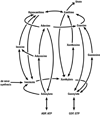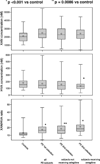CSF xanthine, homovanillic acid, and their ratio as biomarkers of Parkinson's disease
- PMID: 21784416
- PMCID: PMC4120020
- DOI: 10.1016/j.brainres.2011.06.057
CSF xanthine, homovanillic acid, and their ratio as biomarkers of Parkinson's disease
Abstract
Diminished nigrostriatal dopaminergic neurotransmission is a biochemical hallmark of Parkinson's disease. Despite this, a reliable trait biomarker of sporadic Parkinson's disease has not emerged from measurements of cerebrospinal fluid dopamine metabolites. Previous studies have highlighted strong neurochemical relationships between dopamine and various purine compounds. In this study, we analyzed cerebrospinal fluid concentrations of homovanillic acid (the major catabolite of dopamine) and the purine compound xanthine for a comparison of 217 unmedicated Parkinson's disease subjects and 26 healthy controls. These compounds were highly correlated for both the Parkinson's disease subjects (r=0.68) and for controls (r=0.73; both groups, p<0.001). While neither homovanillic acid nor xanthine concentrations differentiated Parkinson's disease from controls, their ratio did. For controls, the mean [xanthine]/[homovanillic acid] quotient was 13.1±5.5 as compared to the Parkinson's disease value of 17.4±6.7 at an initial lumbar CSF collection (p=0.0017), and 19.7±8.7 (p<0.001) at a second CSF collection up to 24 months later. The [xanthine]/[homovanillic acid] ratio in the Parkinson's disease subjects differed as a function of disease severity, as measured by the sum of Unified Parkinson's Disease Rating Scale Activities of Daily Living and Motor Exam ratings. The [xanthine]/[homovanillic acid] ratio also increased between the first and second CSF collections, suggesting that this quotient provides both a state and trait biomarker of Parkinson's disease. These observations add to other neurochemical evidence that links purine metabolism to Parkinson's disease.
Copyright © 2011. Published by Elsevier B.V.
Figures


Similar articles
-
Homovanillic acid in CSF of mild stage Parkinson's disease patients correlates with motor impairment.Neurochem Int. 2017 May;105:58-63. doi: 10.1016/j.neuint.2017.01.007. Epub 2017 Jan 18. Neurochem Int. 2017. PMID: 28108196
-
Elevated 5-S-cysteinyldopamine/homovanillic acid ratio and reduced homovanillic acid in cerebrospinal fluid: possible markers for and potential insights into the pathoetiology of Parkinson's disease.J Neural Transm (Vienna). 1996;103(4):433-46. doi: 10.1007/BF01276419. J Neural Transm (Vienna). 1996. PMID: 9617787
-
Cerebrospinal fluid homovanillic acid in the DATATOP study on Parkinson's disease. Parkinson Study Group.Arch Neurol. 1995 Mar;52(3):237-45. doi: 10.1001/archneur.1995.00540270025015. Arch Neurol. 1995. PMID: 7872875 Clinical Trial.
-
Recent advances in CSF biomarkers for Parkinson's disease.Parkinsonism Relat Disord. 2012 Jan;18 Suppl 1:S49-51. doi: 10.1016/S1353-8020(11)70017-7. Parkinsonism Relat Disord. 2012. PMID: 22166453 Review.
-
Recent advances in Parkinson's disease therapy: use of monoamine oxidase inhibitors.Expert Rev Neurother. 2005 Nov;5(6):811-21. doi: 10.1586/14737175.5.6.811. Expert Rev Neurother. 2005. PMID: 16274338 Review.
Cited by
-
Clinical Insights into Mitochondrial Neurodevelopmental and Neurodegenerative Disorders: Their Biosignatures from Mass Spectrometry-Based Metabolomics.Metabolites. 2021 Apr 10;11(4):233. doi: 10.3390/metabo11040233. Metabolites. 2021. PMID: 33920115 Free PMC article. Review.
-
Enhancement of the organic acid content and antioxidant capacity of yellow whey through fermentation with Lacticaseibacillus casei YQ336.World J Microbiol Biotechnol. 2023 Dec 26;40(2):53. doi: 10.1007/s11274-023-03874-z. World J Microbiol Biotechnol. 2023. PMID: 38146044
-
Cerebrospinal fluid biomarker candidates for parkinsonian disorders.Front Neurol. 2013 Jan 21;3:187. doi: 10.3389/fneur.2012.00187. eCollection 2012. Front Neurol. 2013. PMID: 23346074 Free PMC article.
-
Current advances in metabolomic studies on non-motor psychiatric manifestations of Parkinson's disease (Review).Exp Ther Med. 2021 Sep;22(3):1010. doi: 10.3892/etm.2021.10443. Epub 2021 Jul 15. Exp Ther Med. 2021. PMID: 34345292 Free PMC article. Review.
-
Inflammatory mediators as biomarkers in brain disorders.Inflammation. 2014 Jun;37(3):639-48. doi: 10.1007/s10753-013-9780-2. Inflammation. 2014. PMID: 24292800 Review.
References
-
- Amorini AM, Petzold A, Tavazzi B, Eikelenboom J, Keir G, Belli A, Giovannoni G, Di Pietro V, Polman C, D’Urso S, Vagnozzi R, Uitdehaag B, Lazzarino G. Increase of uric acid and purine compounds in biological fluids of multiple sclerosis patients. Clin. Biochem. 2009;42:1001–1006. - PubMed
-
- Antoniades CA, Barker RA. The search for biomarkers in Parkinson’s disease: a critical review. Expert. Rev. Neurother. 2008;8:1841–1852. - PubMed
-
- Arduíno DM, Esteves AR, Oliveira CR, Cardoso SM. Mitochondrial metabolism modulation: a new therapeutic approach for Parkinson’s disease. CNS Neurol. Disord. Drug Targets. 2010;9:105–119. - PubMed
-
- Ascherio A, LeWitt PA, Xu K, Eberly S, Watts A, Matson WR, Marras C, Kieburtz K, Rudolph A, Bogdanov MB, Schwid SR, Tennis M, Tanner CM, Beal MF, Lang AE, Oakes D, Fahn S, Shoulson I, Schwarzschild MA. Urate as a predictor of the slower rate of clinical decline in Parkinson disease. Arch. Neurol. 2009;66:1460–1468. - PMC - PubMed
-
- Ballenger JC, Post RM, Goodwin FK. Neurochemistry of cerebrospinal fluid in normal individuals. In: Wood JH, editor. Neurobiology of Cerebrospinal Fluid. Vol. 2. New York: Plenum Press; 1980. pp. 143–155.
Publication types
MeSH terms
Substances
Grants and funding
LinkOut - more resources
Full Text Sources
Medical

